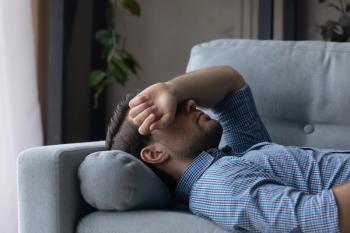
An Overlooked Strategy for Antidepressant Augmentation?
A hypnotic might be a good option for augmenting depression treatment, but which hypnotic has the best evidence for efficacy?
Antidepressant augmentation is a common practice, and there are many strategies from which to choose. The
1. Natural treatments: omega-3 fatty acids, L-methylfolate, or light therapy
2. Antipsychotics: aripiprazole, risperidone, or quetiapine
3. Antidepressants: bupropion, imipramine, or mirtazapine
4. Lithium
5. Liothyronine (T3)
When rapid relief is the priority, an antipsychotic might be the best choice. For favorable tolerability, there is bupropion or a natural therapy, and lithium has strong antisuicide effects, if that is a concern. But what if insomnia is the chief complaint? Mirtazapine is tempting here, but this medication carries a risk of weight gain and did not perform well in several recent, well-designed augmentation trials.2 Instead, a standard hypnotic may be a good option when patients continue to have depression and insomnia on an antidepressant, but not just any hypnotic.
Eszopiclone: The Science Behind Its Potential Effect on Depression
In the early 2000s, a group of sleep researchers set out to investigate whether hypnotics could improve mood in patients with depression and insomnia. The results did not pan out exactly as expected, but they point the way toward a medication with unique potential in depression.
But first, investigators had to overcome a hurdle. At the time, it was thought that hypnotics might cause depression through their sedative effects. That concern was partly put to rest in a 1999 study that tested whether zolpidem could relieve selective serotonin reuptake inhibitor [SSRI]-induced insomnia in patients who had otherwise recovered on the antidepressant. The sleep problems improved with zolpidem and, to the investigators’ relief, the sedating medication did not worsen depression.3
Buoyed by this result, the manufacturer of eszopiclone funded a large trial to see if depression might actually improve with their hypnotic. Five hundred and forty-five patients with depression and insomnia were randomized to receive either eszopiclone 3mg or placebo while simultaneously starting a trial of fluoxetine. As expected, the hypnotic improved sleep, but it also improved mood symptoms that were unrelated to sleep. Compared to placebo, those who received eszopiclone experienced a more rapid and complete recovery from depression.4
The same group repeated the study with zolpidem ER in a large trial of similar design. Once again, the hypnotic improved sleep, but this time there was no change in mood.4 Replication in China brought the same negative results, and last year zolpidem failed again to lift mood or reduce suicidality when added to an SSRI in a randomized trial of patients with depression, insomnia, and suicidality.4,5
Meanwhile, eszopiclone repeated its success, improving mood and insomnia in 2 additional trials, 1 of which involved peri- and postmenopausal women with insomnia and depressive symptoms.6,7 Generalized anxiety disorder also improved when eszopiclone was added to an SSRI in a large manufacturer-supported trial that replicated the design of eszopiclone’s pivotal depression trial.8
Both the zolpidem and eszopiclone studies involved many of the same investigators, who had pursued this work with the idea that any hypnotic that improved sleep would indirectly improve mood. But to this day eszopiclone remains the only hypnotic with distinct antidepressant effects (ramelteon has mild preventative benefits in bipolar disorder but is not known to treat depression).9 Whether this is a statistical fluke or a true difference is difficult to say, as eszopiclone has not gone head-to-head against other hypnotics in depression. However, eszopiclone does have a unique mechanism of action that might explain its antidepressant effects. To understand that we need to turn to the GABAA receptor.
Compared to the benzodiazepines, the z-hypnotics have more limited effects on GABAA, which is thought to explain why they treat sleep but not anxiety. Specifically, the z-hypnotics are selective for the sleep-inducing GABAA α-1 subunit, while benzodiazepines have additional effects on the α-2 and -3 subunits that are involved in anxiety and depression. But eszopiclone is an exception. It acts at all of the α subunits, and may actually be a little more selective for the anxiolytic α-2 and-3.10 This effect is furthered by eszopiclone’s active metabolite, desmethylzopiclone, which is a selective partial agonist at α-2 and -3 with very little α-1 activity (that is a good thing, as it would otherwise cause a lot of daytime sedation).11 In animal models, desmethylzopiclone reduced anxiety without causing sedation or motor impairment.12 Its effects in humans are not well described, but the trials above give us a hint, and the company that launched eszopiclone has patented this metabolite as a potential anxiolytic.
In this way, eszopiclone resembles the benzodiazepines, which have been used to treat depression and hasten the response to antidepressants in over 3 dozen controlled trials.13 In most of those trials, their antidepressant effects were independent of their anxiolytic effects, just as eszopiclone treated symptoms of depression that were unrelated to sleep.
Despite this research, benzodiazepines are not used routinely for depression because of their risk of tolerance and abuse. Those risks may also apply to eszopiclone, but the trials above provide some reassurance. In several of them, eszopiclone was replaced with a placebo after 2 months of treatment without any loss of the antidepressant and anxiolytic gains. Nor was there any rebound insomnia and, in some studies, it stabilized sleep patterns in a way that continued after the hypnotic was stopped.4,8
Does all this elevate eszopiclone to the level of antidepressant augmentation? Possibly. It does have more positive results than some the augmentation strategies that are endorsed by evidence-based guidelines.1 But there are 2 caveats. First, eszopiclone was only studied in patients with comorbid insomnia, but this is not a major hurdle as it is the rare patient with depression who does not struggle with sleep (about 15%).14 More significantly, eszopiclone was started in tandem with an antidepressant in these augmentation trials, so we do not know if it could turn things around when added later, after a few antidepressant failures.
The Bottom Line
When selecting a hypnotic in depression or generalized anxiety disorder, eszopiclone should be on the list. The treatment need not be long-term. Most patients were able to taper off the hypnotic after recovery. To bolster those odds, start out with the expectation of short-term use and guide the patient toward
Dr Aiken is the Mood Disorders Section Editor for Psychiatric TimesTM, the Editor in Chief of
References
1. Giakoumatos CI, Osser D.
2. Jordan T, Aiken C.
3. Asnis GM, Chakraburtty A, DuBoff EA, et al.
4. Kishi T, Matsunaga S, Iwata N.
5. McCall WV, Benca RM, Rosenquist PB, et al.
6. McCall WV, Blocker JN, D'Agostino R Jr, et al.
7. Joffe H, Petrillo L, Viguera A, et al.
8. Pollack M, Kinrys G, Krystal A, et al
9. Kishi T, Nomura I, Sakuma K, et al.
10. Nutt DJ, Stahl SM
11. Fleck MW.
12. Carlson JN, Haskew R, Wacker J, et al.
13. Benasi G, Guidi J, Offidani E, et al.
14. Sunderajan P, Gaynes BN,
Newsletter
Receive trusted psychiatric news, expert analysis, and clinical insights — subscribe today to support your practice and your patients.













